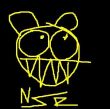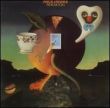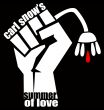| apollos |
|
21 Oct 2009 16:38 | Quote |
Joined: 09 Oct 2009 United States  Karma Karma 
|
ok i know how to make sheet music and stuff but i dont know where the notes i wrote down lie on the guitar! i know which frets are which notes but i dont know which a is which and such when looking at my sheet music and trying to play what i wrote down. |
| fender_bender |
|
22 Oct 2009 07:48 | Quote |
Joined: 09 Oct 2009 United States  Karma Karma: 5 
|
How did you write the music? In your head or on a piano or something? |
| JustJeff |
|
22 Oct 2009 10:19 | Quote |
Joined: way back United States  Lessons: 2 Karma: 21 
|
Well, the guitar spans 4 octaves in range. The low E is the next E lower than middle C. Use a G clef and you're set :) |
| gx1327 |
|
22 Oct 2009 12:29 | Quote |
Joined: 20 Sep 2009 United States  Karma Karma: 9 
|
hang on, i have an excel cheat sheet i will see if i can take a snapshot and upload it...
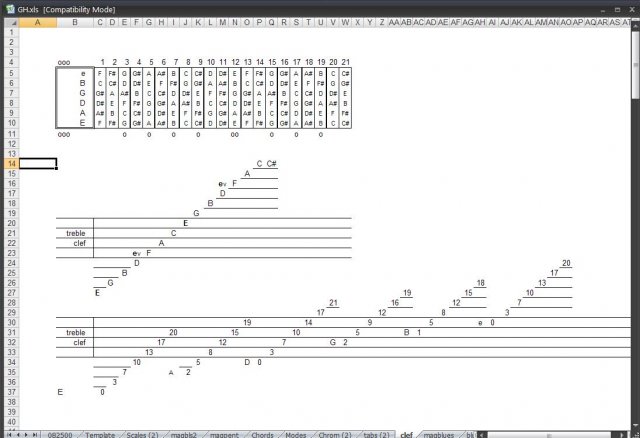
might be too large to display correctly here, but these are where the corresponding notes on a standard-ly tuned guitar line up on the treble clef. the "ev"s mean that the line beneath the "e" is E... since in excel you can't write letters on the lines. for that reason this doesn't have EVERY note on it, but you can fill in the gaps yourself. however this DOES show you the full range of the guitar and where the notes lay on the clef. |
| gx1327 |
|
22 Oct 2009 12:42 | Quote |
Joined: 20 Sep 2009 United States  Karma Karma: 9 
|
oh p.s. my guitar only has 21 frets, so it only spans 3 1/2 octaves :'( |
| apollos |
|
22 Oct 2009 23:43 | Quote |
Joined: 09 Oct 2009 United States  Karma Karma 
|
DOOOD GX1327 I LOVE U MANNN/WOMAN i had been digging in google for hours last night looking for something like that maaannnn. thnx to u other ppl who helped me!! ok dood i looked at ur chart and its startin to make a lil sense
fenderbenderi wrote the music on the scores..i just wrote random notes that looked nice from the c major
can anyone tell me where the 4 octaves start and end on the guitar. |
| RA |
|
23 Oct 2009 05:17 | Quote |
Joined: 24 Sep 2008 United States  Karma Karma: 16 
|
it is kind of silly to try to wright before you can read for your main(?) instrument, or at lest try to do it for an instrument your can't read for.
The guitar is a transposed Instrument, like a sax or trumpet(which are in ether Eb or Bb). but unlike them the guitar is transposed down a whole octave so it is written as if it was in normally C4(middle C). your should see a little 8 at the bottom of the treble clef to note it but if it is a score written for the guitar it is implied
>-----http://en.wikipedia.org/wiki/File:Range_guitar.png-----<
So what does this mean? well the notes on the treble clef are not as it is written. the spot for C4 on Guitars notation is not C4 it is really C3 A whole octave lower.
the other problem(not really a problem but hay) for Guitar, and other string instruments for that mater, are that notes appear more then once. Unlike the piano for instances which C4 is in one place and one place only. For the guitar C4 shows up in five spots and has 16 different fingerings, however low E(E2) has only one spot.
The point and morally of the story is learn how to read music for the guitar before you try to write for it, just because you can read treble G doesn't mean you can read music or anything for that matter. You can learn in two ways get yourself a good teacher or get a book. there are many books, i personally used the first volume of the Berkley books.
|
| carlsnow |
|
23 Oct 2009 07:27 | Quote |
Joined: 29 Apr 2009 United States  Lessons: 2 Karma: 23 
|
RA says: he guitar is transposed down a whole octave so it is written as if it was in normally C4(middle C). your should see a little 8 at the bottom of the treble clef to note it
+
the other problem(not really a problem but hay) for Guitar, and other string instruments for that mater, are that notes appear more then once. Unlike the piano for instances which C4 is in one place and one place only. For the guitar C4 shows up in five spots and has 16 different fingerings, however low E(E2) has only one spot.
what he said ... (and thanks fer saving us the trouble, lol, RA !).
but there ya go mentioning the musician's graveyard, ...Berkley(MA), LOL!
My advice would be to learn **Tab 1st (i know, i know) then use that methodology to aid your staff-reading and writing.
but thats just me...
**= AMENDED:
I was not going to plop THIS down, originally, but as an ex-'Staff-Jockey'; AKA 'a dude who writes staff to Score(s) for later use as musical wallpaper to drape behind TV shows and whatnot', I feel i should.
Tab and Staff are BOTH great to know.
BUT
as i stated above, imo a guitarist would do well to learn staff first.
->Notice i did not say "only".
----(i may need a new thread fer this so i'll go "bare-bones")----
Perhaps RA and i differ here, perhaps not, BUT i am of the pinion that as you learn the sound of the fretboard via Tab and practice, you will become more 'tuned' and ready for Staff (not that its such a huge leap up).
When you do decide you are ready, or ready enough, to learn Staff...Find a Keyboard!
(imo musicians should know more than their 'primary instrument', even if only well enough 'to get by')
(I'll use Piano as 'default)
The Piano is much easier to learn scales, modes, and especially Chords on, than the guitar, so don't fret it! (a Pun!)
Staff fits Piano like a glove and is most easily viewed, heard and understood using a Piano (or any keyboard) .. I often refer to it as (remember the books?) 'The Major Scale For Dummies" (no-one throw anything)and refer to it quite often when teaching my 'under 21' students (young minds are sponges).
Since I'll be writing a "Tab or Staff or Both" Post I'll wrap this up.
at ANY skill level it is helpful to learn both Tab and Staff Notation.
Oh! and, uh..
RAWK!
Cs
|
| gx1327 |
|
23 Oct 2009 11:18 | Quote |
Joined: 20 Sep 2009 United States  Karma Karma: 9 
|
apollos says: can anyone tell me where the 4 octaves start and end on the guitar.
i have a couple of other helpful "cheat sheets" that i made. i'm not going to harp on you for not learning music the right way or anything. that's not my place because i don't really know guitar, but these are things that i've learned and put in a neat format as a helpful reminder.
i called this "octave notes" i couldn't think of a better name. the numbers 1-2-3-4 are all relative to my guitar. as others have stated they may not transpose correctly to a different instrument or the trebel clef itself. they are simply in relation to the guitar.

p.s. it's "mannn" |
| gx1327 |
|
23 Oct 2009 11:34 | Quote |
Joined: 20 Sep 2009 United States  Karma Karma: 9 
|
also:
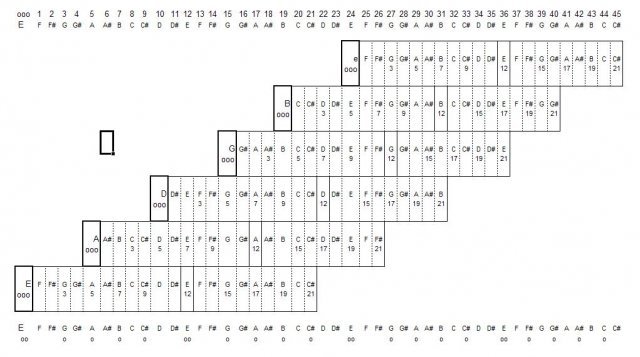
|
| RA |
|
23 Oct 2009 23:41 | Quote |
Joined: 24 Sep 2008 United States  Karma Karma: 16 
|
@Carl
ya like a said i only have the book and it is what i used to learn how to read. Plus now if any one says anything I can pull it out and shout "I READ YOUR BOOK!" but shhh i didn't finish vol 2 or get to vol 3 we won't tell them that. OO and yes i agree, i don't like Tab per say but you shouldn't learn the Guitar with notation I don't know who would(classical snobs that's who). Hell notation doesn't even really work for jazz(or should i say American[I include classical, samba, bossa nova, etc, not just us U.S.A citizens are Americans]) music it just gets by at best and hell yess to staff being made for keyboards, Staff based in C, keyboard based in C need i say more? and i feel it to be mandatory to learn another instrument based on what you want to do with the guitar(I'm big on perspective thinking). I have always thought all these shred guitarist wouldn't suck so much if they learned another strictly single note instrument. Obviously, a sax or something would be nice but i feel it is better to stick in your family so a violin should be there secondary, and why don't they tune in fourths there not playing chords, jazz single notes do it, damn you rock and roll.
@gx1327
kudos to you for making all of these yourself(you did right?). I my self do the same thing(though I hand write them out, computers and me have a mural hated of one other). I once even tried to chart all the possible Diatonic chords, I failed. but it is funny cause this made me look back at my old sheets/charts and sometimes it is like what the ** was i thinking it is hilarious at points. I also love how you have different charts for the same thing which is the only way to really learn something(to tackle it form all perspectives).
My only problem is the first octave chart. And you right it doesn't fit the actual frequencies and you stated you didn't want it to. But I'm going to try to change you mind. First, that me say your chart is completely right for what you say it is, but isn't the whole point in this is to study so we can play/communicate with other musicians who play the guitar and those who don't. It is why we tune to A-440(or to whatever the piano/other hard things to tune are at) so we are playing/thinking(sub-con and con) in harmony together. sure you can tune the guitar with it self at A-400 but you can only play with yourself. And what happens when you tell a piano player to play E1 and he is playing in the contra-bass making a confusing moment when you each think the others crazy. and if you ever do plan on reading it will confuses the crap out of you case your thinking in a other way(again it is not wrong most things in music are a matter of perspective). So my recommendation is to make low E, E2. Then have the the "C" on the low E string be C3 then the next C2 and follow the "C"s not the "E"s. |
| apollos |
|
24 Oct 2009 00:00 | Quote |
Joined: 09 Oct 2009 United States  Karma Karma 
|
RA well i was writing notes cuz i was trying to figure out this info for myself because im gettin impatient wiht my teacher and i wanna learn some of this stuff right now. i figured if i learn guitar notation it will make me a better player...
gx1327 ok i figured u hwere a guy i was just makin sure. and thnx for the cheat sheets im sure they will come in handy. some of the charts confuse me liek the octave thing but ill understand it once my teacher shows me more stuff. i was trying to find the third c octave where guitar is "same" as the pianos fourth c when transposed
|
| RA |
|
24 Oct 2009 00:16 | Quote |
Joined: 24 Sep 2008 United States  Karma Karma: 16 
|
ask him/her for a book or sheets to go along with your lesson so you can practice reading when you not with them, or find a better teacher if you feel he/she is lacking. I can recommend stuff but it is better if you get it form him/her.
do you want to know where C3 is on the guitar or C4 or are you asking where they are on the piano? C4 on the piano is generally the C key below the name of the maker(it is not on mine). But on Gx1327 chart C3=C1 and C4=C2 |
| gx1327 |
|
24 Oct 2009 01:16 | Quote |
Joined: 20 Sep 2009 United States  Karma Karma: 9 
|
this is why i put "cheat" in quotes when i say "cheat sheet" --- these are practices i do while i'm at work. don't tell my boss, but i find the guitar infinitely more interesting than welding procedures.
this brings me to something that's been on my mind for a bit...
RA
carlsnow
you guys obviously are wise beyond your years... but for the life of me, i CANNOT understand a dam thing you are saying. don't get me wrong! i appreciate your presence, but i cannot comprehend a lot of what you guys are saying!!!
RA says: My only problem is the first octave chart. And you right it doesn't fit the actual frequencies and you stated you didn't want it to. But I'm going to try to change you mind. First, that me say your chart is completely right for what you say it is, but isn't the whole point in this is to study so we can play/communicate with other musicians who play the guitar and those who don't.
this seems like a nitpick to me, honestly. if you go to my "octave" whatever chart (i forgot what i called it), you can just take the #s and add one. open, 6th string E on a standard guitar is "E2" in the treble scale. correct? so just add 1 to each note IF you are transposing. but i already clarified that the cheathseet was realtive to a single instrument.
i actually spend a lot of time at my job making cheat sheets for the guitar. i'm not GOOD, but i'm good at the theory. i will try to get a few together to upload as a package AND i do appreciate the input/criticism (i will change the octaves to correspond to the treble clef) |
| apollos |
|
24 Oct 2009 01:23 | Quote |
Joined: 09 Oct 2009 United States  Karma Karma 
|
cant wait till i get good at theory ugh lool
thanks Ra and Gx and carl... |
| RA |
|
24 Oct 2009 02:02 | Quote |
Joined: 24 Sep 2008 United States  Karma Karma: 16 
|
first of let me say I don't think I'm good or wise beyond anything I'm on the ground. It has become The more I know the more I know I don't know crap. I really don't think it ends, take for instances when i discovered the whole Lydian-dominate bit about how a ii-V-I now becomes ii-bII-I my world explode and I'm still in shambles. Joe pass still makes me cry the man amazying, and then he talks about it like, what? it is simple, just a little this and that. watch Ted Greene play(i really recommend every one check him out and not just that one video hell what the whole seminar if you have the time)
>------http://www.youtube.com/watch?v=f2t4xD3Ng1A----<
but thank you, were on the same journey doesn't really matter where you are as long as you there.
and yes I'm a bit nitpicky I try to fight it but it wins a lot of the time. but i feel this is not really that nitpicky and you seem just a little(only a little) bit confused on what I'm trying to get at. Here is a chart the shows the relative octaves of different types of instruments
>------------http://en.wikipedia.org/wiki/Range_(music)--------<
so the point I'm trying to make is E1 is has a feq of what it looks to be about 39Hz(?) (contra-bass) while E2 is about 85Hz(?)(bass). So my point about the chart is not about where it is on and staff notation (be it a treble G, bass F, or those funny one no one uses any more), but where the string is in shape and time compared to other instruments all tuned to A-440 |
| apollos |
|
25 Oct 2009 00:46 | Quote |
Joined: 09 Oct 2009 United States  Karma Karma 
|
im watching it now |
|
|




